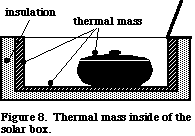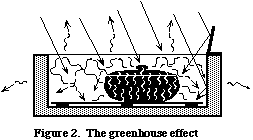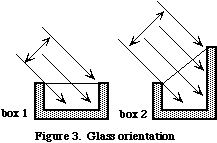Principles of Solar Box Cooker Design
By Mark Aalfs, Solar Cookers International
e-mail: aalfs@yahoo.com
 The purpose of this paper is to summarize the basic principles that are used in the design of solar box cookers.
The purpose of this paper is to summarize the basic principles that are used in the design of solar box cookers.
People use solar cookers primarily to cook food and pasteurize water, although additional uses are continually being developed. Numerous factors including access to materials, availability of traditional cooking fuels, climate, food preferences, cultural factors, and technical capabilities, affect people's approach to solar cooking.
With an understanding of basic principles of solar energy and access to simple materials such as cardboard, aluminum foil, and glass, one can build an effective solar cooking device. This paper outlines the basic principles of solar box cooker design and identifies a broad range of potentially useful construction materials.
These principles are presented in general terms so that they are applicable to a wide variety of design problems. Whether the need is to cook food, pasteurize water, or dry fish or grain; the basic principles of solar, heat transfer, and materials apply. We look forward to the application of a wide variety of materials and techniques as people make direct use of the sun's energy.
The following are the general concepts relevant to the design or modification of a solar box cooker:
The basic purpose of a solar box cooker is to heat things up - cook food, purify water, and sterilize instruments - to mention a few.
A solar box cooks because the interior of the box is heated by the energy of the sun. Sunlight, both direct and reflected, enters the solar box through the glass or plastic top. It turns to heat energy when it is absorbed by the dark absorber plate and cooking pots. This heat input causes the temperature inside of the solar box cooker to rise until the heat loss of the cooker is equal to the solar heat gain. Temperatures sufficient for cooking food and pasteurizing water are easily achieved.
Given two boxes that have the same heat retention capabilities, the one that has more gain, from stronger sunlight or additional sunlight via a reflector, will be hotter inside.
Given two boxes that have equal heat gain, the one that has more heat retention capabilities - better insulated walls, bottom, and top - will reach a higher interior temperature.
The following heating principles will be considered first:
Conduction:
The handle of a metal pan on a stove or fire becomes hot through the transfer of heat from the fire through the materials of the pan, to the materials of the handle. In the same way, heat within a solar box is lost when it travels through the molecules of tin foil, glass, cardboard, air, and insulation, to the air outside of the box.
 As the density and weight of the materials within the insulated shell of a solar box cooker increase, the capacity of the box to hold heat increases. The interior of a box including heavy materials such as rocks, bricks, heavy pans, water, or heavy foods will take longer to heat up because of this additional heat storage capacity. The incoming energy is stored as heat in these heavy materials, slowing down the heating of the air in the box.
As the density and weight of the materials within the insulated shell of a solar box cooker increase, the capacity of the box to hold heat increases. The interior of a box including heavy materials such as rocks, bricks, heavy pans, water, or heavy foods will take longer to heat up because of this additional heat storage capacity. The incoming energy is stored as heat in these heavy materials, slowing down the heating of the air in the box.
These dense materials, charged with heat, will radiate that heat within the box, keeping it warm for a longer period at the day's end.
By Mark Aalfs, Solar Cookers International
e-mail: aalfs@yahoo.com
 The purpose of this paper is to summarize the basic principles that are used in the design of solar box cookers.
The purpose of this paper is to summarize the basic principles that are used in the design of solar box cookers.People use solar cookers primarily to cook food and pasteurize water, although additional uses are continually being developed. Numerous factors including access to materials, availability of traditional cooking fuels, climate, food preferences, cultural factors, and technical capabilities, affect people's approach to solar cooking.
With an understanding of basic principles of solar energy and access to simple materials such as cardboard, aluminum foil, and glass, one can build an effective solar cooking device. This paper outlines the basic principles of solar box cooker design and identifies a broad range of potentially useful construction materials.
These principles are presented in general terms so that they are applicable to a wide variety of design problems. Whether the need is to cook food, pasteurize water, or dry fish or grain; the basic principles of solar, heat transfer, and materials apply. We look forward to the application of a wide variety of materials and techniques as people make direct use of the sun's energy.
The following are the general concepts relevant to the design or modification of a solar box cooker:
HEAT PRINCIPLES
The basic purpose of a solar box cooker is to heat things up - cook food, purify water, and sterilize instruments - to mention a few.A solar box cooks because the interior of the box is heated by the energy of the sun. Sunlight, both direct and reflected, enters the solar box through the glass or plastic top. It turns to heat energy when it is absorbed by the dark absorber plate and cooking pots. This heat input causes the temperature inside of the solar box cooker to rise until the heat loss of the cooker is equal to the solar heat gain. Temperatures sufficient for cooking food and pasteurizing water are easily achieved.
Given two boxes that have the same heat retention capabilities, the one that has more gain, from stronger sunlight or additional sunlight via a reflector, will be hotter inside.
Given two boxes that have equal heat gain, the one that has more heat retention capabilities - better insulated walls, bottom, and top - will reach a higher interior temperature.
The following heating principles will be considered first:
A. Heat gain
Greenhouse effect: This effect results in the heating of enclosed spaces into which the sun shines through a transparent material such as glass or plastic. Visible light easily passes through the glass and is absorbed and reflected by materials within the enclosed space. | The light energy that is absorbed by dark pots and the dark absorber plate underneath the pots is converted into longer wavelength heat energy and radiates from the interior materials. Most of this radiant energy, because it is of a longer wavelength, cannot pass back out through the glass and is therefore trapped within the enclosed space.The reflected light is either absorbed by other materials within the space or, because it doesn't change wavelength, passes back out through the glass. Critical to solar cooker performance, the heat that is collected by the dark metal absorber plate and pots is conducted through those materials to heat and cook the food. |
 | Glass orientation: The more directly the glass faces the sun, the greater the solar heat gain. Although the glass is the same size on box 1 and box 2, more sun shines through the glass on box 2 because it faces the sun more directly. Note that box 2 also has more wall area through which to lose heat. |
 | Reflectors, additional gain: Single or multiple reflectors bounce additional sunlight through the glass and into the solar box. This additional input of solar energy results in higher cooker temperatures. |
B. Heat loss
The Second Law of Thermodynamics states that heat always travels from hot to cold. Heat within a solar box cooker is lost in three fundamental ways: Conduction, Radiation, and ConvectionConduction:
The handle of a metal pan on a stove or fire becomes hot through the transfer of heat from the fire through the materials of the pan, to the materials of the handle. In the same way, heat within a solar box is lost when it travels through the molecules of tin foil, glass, cardboard, air, and insulation, to the air outside of the box.
   | The solar heated absorber plate conducts heat to the bottoms of the pots. To prevent loss of this heat via conduction through the bottom of the cooker, the absorber plate is raised from the bottom using small insulating spacers as in figure 6.Radiation: Things that are warm or hot -- fires, stoves, or pots and food within a solar box cooker -- give off heat waves, or radiate heat to their surroundings. These heat waves are radiated from warm objects through air or space. Most of the radiant heat given off by the warm pots within a solar box is reflected from the foil and glass back to the pots and bottom tray. Although the transparent glazings do trap most of the radiant heat, some does escape directly through the glazing. Glass traps radiant heat better than most plastics. Convection: Molecules of air move in and out of the box through cracks. They convect. Heated air molecules within a solar box escape, primarily through the cracks around the top lid, a side "oven door" opening, or construction imperfections. Cooler air from outside the box also enters through these openings. |
C. Heat storage:
 As the density and weight of the materials within the insulated shell of a solar box cooker increase, the capacity of the box to hold heat increases. The interior of a box including heavy materials such as rocks, bricks, heavy pans, water, or heavy foods will take longer to heat up because of this additional heat storage capacity. The incoming energy is stored as heat in these heavy materials, slowing down the heating of the air in the box.
As the density and weight of the materials within the insulated shell of a solar box cooker increase, the capacity of the box to hold heat increases. The interior of a box including heavy materials such as rocks, bricks, heavy pans, water, or heavy foods will take longer to heat up because of this additional heat storage capacity. The incoming energy is stored as heat in these heavy materials, slowing down the heating of the air in the box.These dense materials, charged with heat, will radiate that heat within the box, keeping it warm for a longer period at the day's end.
.jpg)
.jpg)






No comments:
Post a Comment